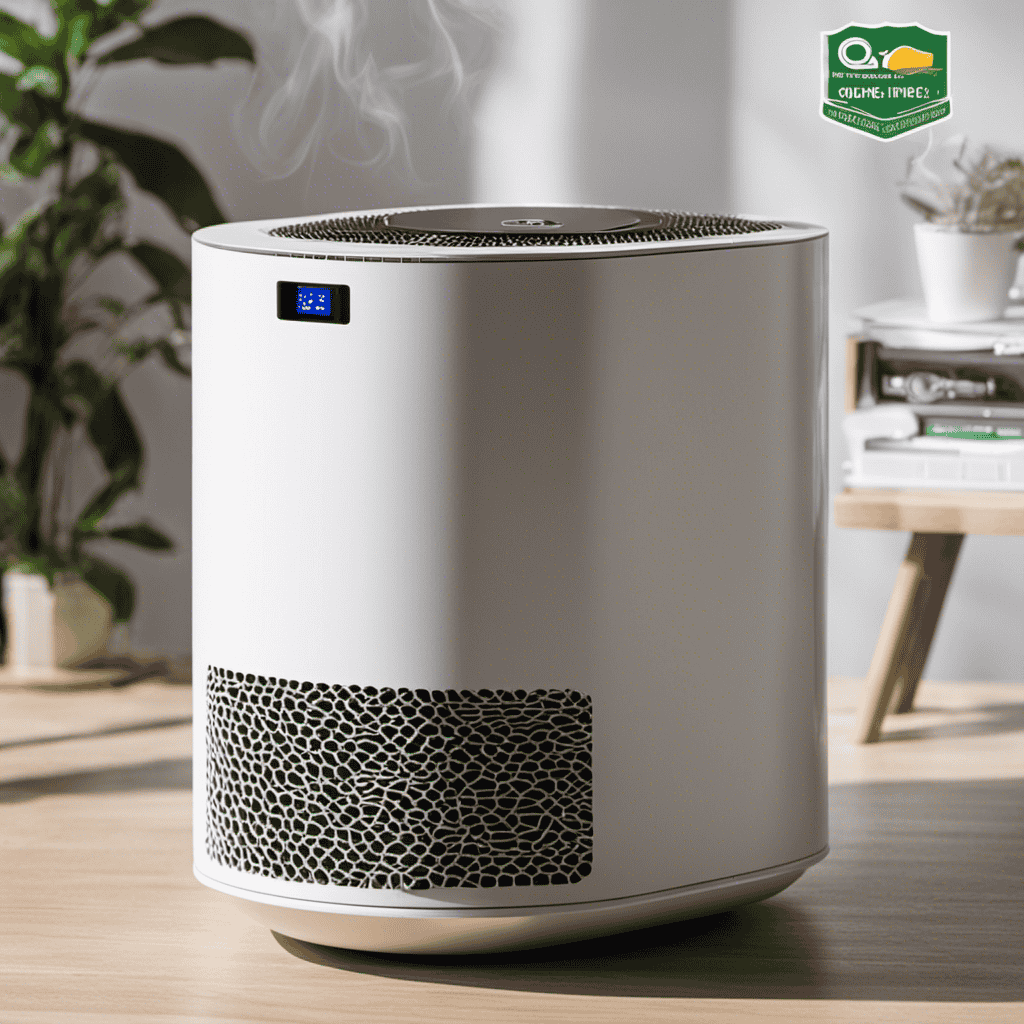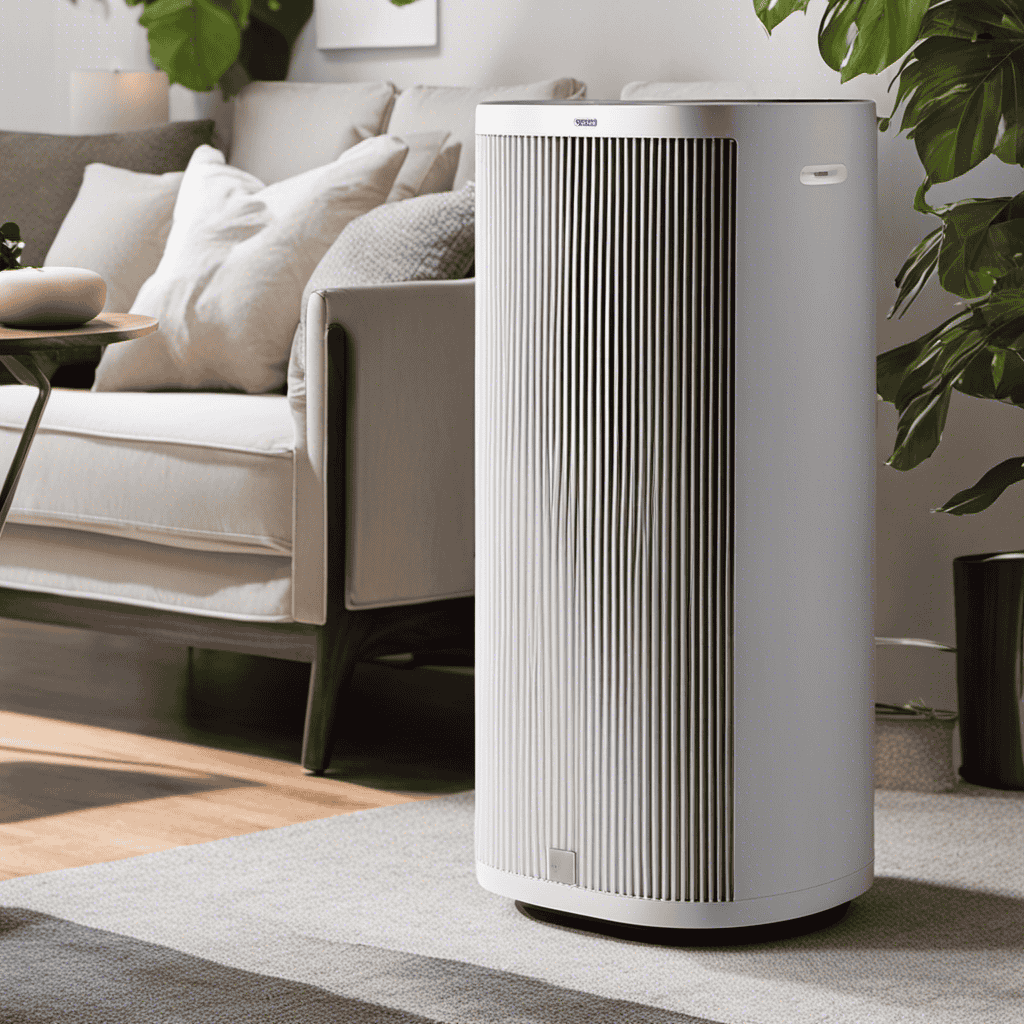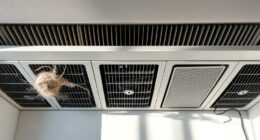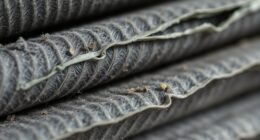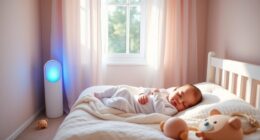I have always been told that prevention is key when it comes to dealing with mold in your home. It is better to prevent mold from growing as it can be a health hazard and difficult to remove once it spreads.
That’s where an air purifier comes in. In this article, I’ll guide you through the process of choosing the right air purifier for mold, proper placement, maintenance, and additional steps to eliminate mold.
Let’s dive in and ensure your home is mold-free once and for all.
Key Takeaways
- Mold thrives in damp and humid environments, and exposure to mold can lead to respiratory issues and worsen asthma symptoms.
- When choosing an air purifier for mold, consider the size of the room and look for ones with HEPA filters and activated carbon filters to effectively capture mold spores and remove unpleasant odors.
- Proper placement of the air purifier is important for maximum coverage, such as placing it in a central location or near areas where you spend the most time.
- To maintain the effectiveness of your air purifier, regularly clean or replace the filters according to the manufacturer’s instructions and consider supplementing air purification methods with essential oils, activated charcoal, vinegar solutions, and baking soda.
Understanding the Dangers of Mold
You should understand the dangers of mold and how it can affect your health. Mold is a type of fungus that thrives in damp and humid environments, such as bathrooms, basements, and kitchens. It releases spores into the air, which can be inhaled and cause various health problems.
Exposure to mold can lead to respiratory issues like coughing, wheezing, and throat irritation. It can also trigger allergies and worsen asthma symptoms. Additionally, mold produces mycotoxins, which are toxic substances that can have serious long-term effects on your health.
To protect yourself and your loved ones, it is crucial to identify health risks associated with mold and take effective mold removal techniques. By doing so, you can create a safe living environment and prevent any further health complications.
Now, let’s move on to identifying mold in your home.
Identifying Mold in Your Home
Identifying mold in your home can be done by looking for visible signs such as discolored patches or a musty smell. As someone who has dealt with mold issues in the past, I know how important it is to catch it early before it spreads and becomes a health hazard.
Here are some ways I have found helpful in identifying mold:
-
Look for visible signs:
-
Discolored patches on walls, ceilings, or floors
-
Black, green, or white specks that resemble dirt or soot
-
Pay attention to smells:
-
A musty or earthy odor that lingers in certain areas of your home
It’s crucial to address mold growth promptly as it can cause various health risks, including respiratory problems, allergies, and even infections.
In my next subtopic, I’ll share effective mold removal techniques that have worked for me in the past. Stay tuned!
Choosing the Right Air Purifier for Mold
When choosing the right air purifier for mold, it’s important to consider the size of the room and the specific needs of your home.
Mold spores can be microscopic and easily spread throughout the air, so you need a purifier that can effectively capture and remove them. Look for air purifiers with HEPA filters, as they are highly efficient at trapping mold spores.
Additionally, consider models with activated carbon filters, as these can help remove any unpleasant odors associated with mold. Some air purifiers also feature UV-C light technology, which can kill mold spores and prevent them from reproducing.
It’s also important to choose a purifier that is suitable for the size of your room, as larger rooms may require a more powerful unit.
Proper Placement of Your Air Purifier
Properly positioning your air purifier is crucial for optimal performance and efficiency. By strategically placing your air purifier, you can effectively improve indoor air quality and enjoy the many benefits that air purifiers offer.
Here are some tips to help you position your air purifier effectively:
-
Placement considerations:
-
Identify the primary source of indoor air pollution, such as a specific room or area.
-
Keep the air purifier away from obstacles like furniture or walls to ensure proper air circulation.
-
Consider placing the air purifier in a central location to maximize its coverage.
-
Room-specific placement:
-
In the bedroom, place the air purifier near your bed to ensure clean air while you sleep.
-
In the living room, position the air purifier close to areas where you spend the most time, like the couch or TV.
Maintaining Your Air Purifier for Maximum Effectiveness
To keep your air purifier working effectively, remember to regularly clean or replace the filters.
Cleaning techniques for air purifier filters vary depending on the type of filter. For pre-filters, simply vacuuming or rinsing them with water can remove larger particles. HEPA filters, on the other hand, require more thorough cleaning. Gently tapping or brushing the filter can help dislodge trapped particles, and some filters can even be washed with water or cleaned with a vacuum cleaner. However, it’s important to check the manufacturer’s instructions for proper cleaning techniques.
While cleaning can extend the lifespan of filters, eventually they will need to be replaced. Most filters should be replaced every 6 to 12 months, but this can vary depending on usage and air quality.
Regularly cleaning or replacing the filters is essential for maintaining the effectiveness of your air purifier and ensuring clean, healthy air in your home.
Supplementing Air Purification Methods
After learning how to properly maintain my air purifier, I decided to explore alternative methods and natural remedies to supplement its effectiveness. Here are a few options I discovered:
-
Essential oils: Adding a few drops of essential oils, such as tea tree or eucalyptus, to the air purifier can help kill mold spores and freshen the air.
-
Activated charcoal: Placing a bowl of activated charcoal near the air purifier can absorb mold spores and odors.
Note: Remember to replace the charcoal regularly to ensure its effectiveness. -
Vinegar solution: Using a mixture of vinegar and water, I sprayed areas prone to mold growth. Vinegar’s acidic properties help kill mold spores and prevent further growth.
-
Baking soda: Sprinkling baking soda on carpets and upholstery before vacuuming can help eliminate mold spores and remove musty odors.
Note: Be sure to vacuum thoroughly to remove all the baking soda.
Additional Steps to Eliminate Mold
For an extra layer of protection against mold, you could consider using a dehumidifier in your home. By reducing the moisture levels in the air, a dehumidifier helps create an environment that is less conducive to mold growth. However, it is important to note that a dehumidifier alone may not completely eliminate mold and additional steps may be necessary.
One such step is additional cleaning. Regularly cleaning and disinfecting surfaces in your home can help prevent the growth of mold. Focus on areas that are prone to moisture, such as bathrooms and basements. Use a mixture of bleach and water to remove any visible mold and disinfect the area.
If you are dealing with a severe mold problem or if the mold keeps coming back, it may be time to seek professional help. A professional mold remediation company has the expertise and equipment to safely and effectively remove mold from your home. They can identify the source of the mold and take appropriate measures to eliminate it.
In summary, using a dehumidifier can provide an additional layer of protection against mold. However, it is important to supplement this with additional cleaning and, if needed, seek professional help for a thorough and effective mold removal process.
| Additional Cleaning | Professional Help |
|---|---|
| Regularly clean and disinfect surfaces | Seek professional mold remediation company |
| Focus on moisture-prone areas | Expertise and equipment for safe and effective removal |
| Use bleach and water mixture for visible mold | Identify source and take appropriate measures |
| Prevents mold growth | Thorough and effective mold removal process |
Prevention Tips for Future Mold Growth
Take proactive measures to prevent future mold growth by regularly inspecting your home for any sources of moisture, such as leaks or water damage. By addressing the root cause of moisture, you can effectively prevent mold from taking hold in your living environment.
Here are some prevention tips to keep your home mold-free:
- Keep an eye out for any signs of leaks or water damage, such as stains on the ceiling or walls.
- Ensure proper ventilation in areas prone to moisture, like bathrooms and kitchens, by using exhaust fans or opening windows.
- Use dehumidifiers to maintain optimal humidity levels, especially in basements and crawl spaces.
- Regularly clean and dry areas prone to moisture, such as shower curtains, bathroom tiles, and window sills.
- Repair any plumbing issues promptly to prevent water buildup and potential mold growth.
Frequently Asked Questions
Can an Air Purifier Completely Eliminate Mold From My Home?
Yes, an air purifier can effectively eliminate mold from my home. The benefits of using an air purifier include reducing mold spores in the air, improving indoor air quality, and minimizing the risk of mold-related health issues.
Are There Any Health Risks Associated With Mold Exposure?
There are health risks associated with mold exposure, including respiratory issues, allergies, and even infections. Symptoms may include coughing, wheezing, and skin irritation. It is important to address mold problems promptly to minimize these risks.
How Long Does It Take for an Air Purifier to Remove Mold Spores From the Air?
Using an air purifier is a great way to remove mold spores from the air. The effectiveness of the purifier depends on the model you choose. Some recommended models can eliminate mold spores within a few hours.
Can an Air Purifier Prevent Mold Growth in the Future?
Yes, an air purifier can help prevent future mold growth by filtering out mold spores and other airborne contaminants. Regular air purifier maintenance is important to ensure its effectiveness in providing the benefits of clean and healthy air.
Is It Necessary to Hire a Professional to Remove Mold if I Already Have an Air Purifier?
Hiring professionals for mold removal may be necessary, even if an air purifier is used. DIY methods may not fully eliminate the problem. "Better safe than sorry" applies when it comes to mold.
Conclusion
In conclusion, getting rid of mold with an air purifier is a thorough and effective solution.
By understanding the dangers of mold and identifying it in your home, you can take the necessary steps to eliminate it.
Choosing the right air purifier and placing it correctly will maximize its effectiveness.
Regular maintenance and supplementing with other purification methods will ensure mold-free air.
And by following prevention tips, you can avoid future mold growth.
So, say goodbye to mold and hello to a healthier, cleaner home.

